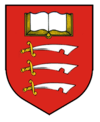School of Computer Science and Electronic Engineering (Essex University)
Former names | Electronic Systems Engineering (1966-2007), Department of Computer Science (1966-2007) |
|---|---|
| Established | 2007 (Following a merger of the departments of Computer Science and Electronic Systems Engineering) |
| Location |
Colchester, United Kingdom Coordinates: 51°53′00″N 0°54′00″E / 51.88333°N 0.9°E |
| Campus | University of Essex, Wivenhoe Park ,Colchester, CO4 3SQ, United Kingdom |
| Website | Essex.ac.uk |
The School of Computer Science and Electronic Engineering at the University of Essex is an academic department that focuses on educating and researching into Computer Science and Electronic Engineering specific matters. It was formed by the merger of two departments, notable for being amongst the first in England in their fields, the Department of Electronic Systems Engineering(1966) and the Department of Computer Science (1966).
Achievements
The School/Department is notable for the following achievements:
- The Department's MSc Masters course in Telecommunications was the first one in the world to cover the complete telecommunication system, including both switching and transmission.[1]
- The world's first telephone based system for deaf people to communicate with each other was invented and developed in the department by Don Pearson in 1981. The system was based on sign language - cameras and display devices were able to work within the limited telephone bandwidth to enable sign language communication two decades before the widespread use of broadband and web-cameras.
- The department produced the first MSc on the Theory of Programming Languages (1970; Laski, Turner) called Program Linguistics.
- Charles Broyden in 1970 developed the BFGS method for numerical optimisation. The method is still the industry standard, in constant use around the world after nearly 40 years.
Current notable research
- The Photonics Hyperhighway project began in 2010 and is planned to run until 2016. It was funded by the Engineering and Physical Sciences Research Council (EPSRC) with an aims to focus on energy-efficient ultra high capacity ICT infrastructure. The project plans to make broadband internet 100 times faster including partnership with the BBC to help broadcast ultra high definition content.[2]
- Current research with the UK Research Network on Artificial Intelligence and Video Game technologies into artificial intelligence and Computer Games [3]
Notable alumni and staff
- Ray Turner, notable for his work on logic in computer science and for his pioneering work in the philosophy of computer science. Current Lecturer at the University.
- Richard Bartle, Co-creator of MUD1 (the first Multi-User Dungeon) and author of Designing Virtual Worlds. Current Lecturer at the University.
- Riccardo Poli, Major contributor to the field of Genetic Programming. Current lecturer at the University.
- Tony Brooker, University's founding Chair of Computer Science 1967.
References
- ↑
- ↑ "The Tavistock and Portman NHS Foundation Trust". Tavi-port.org. Retrieved 3 October 2018.
- ↑
External links
This article is issued from
Wikipedia.
The text is licensed under Creative Commons - Attribution - Sharealike.
Additional terms may apply for the media files.
